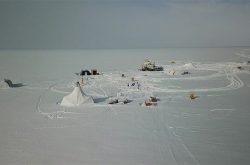
Ancient air samples from one of Antarctica’s snowiest ice core sites may add a new molecule to the record of changes to Earth’s atmosphere over the past century and a half, since the Industrial Revolution began burning fossil fuels on a massive scale.
While carbon dioxide and methane are well known, researchers at the University of Washington and the University of Rochester are part of a team working to trace a much rarer gas, present at less than one in a trillion molecules. Though rare, the atmospheric detergent known as hydroxyl can scrub the atmosphere and determine the fate of more plentiful gases that affect Earth’s climate.
An Antarctic field campaign last winter led by the U.S. and Australia has successfully extracted some of the largest samples of air dating from the 1870s until today. These samples are a first step to learning the changes in hydroxyl concentration over the past 150 years. Early results from the fieldwork were shared this week at the American Geophysical Union’s annual fall meeting in San Francisco.
“It’s probably the most extreme atmospheric chemistry you can do from ice core samples, and the logistics were also extreme,” said Peter Neff, a postdoctoral researcher with dual appointments at the UW and at the University of Rochester.
Read more at UW News »
